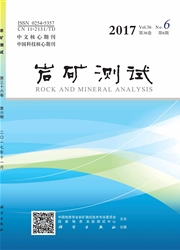

 中文摘要:
中文摘要:
饱和脂肪酸及其同位素组成是重建古环境和古气候的重要代用指标,目前存在多种提取及纯化流程。在全球变化研究中,基于不同原理的纯化流程得到的脂肪酸含量及其同位素组成是否一致,直接影响着该指标应用于不同区域重建结果的对比。本文用两种常见的脂肪酸纯化流程提取脂肪酸标准、现生植物和泥炭样品类脂物,通过对比发现:对脂肪酸标准两种流程都可以得到纯净的单体脂肪酸,而且回收率均较高(85%以上),都是较为可靠的脂肪酸纯化流程;然而对于天然样品,虽然高碳数脂肪酸(碳数〉C24)的回收率相近,流程l却能够获得相对较多的低碳数饱和脂肪酸,如泥炭样品中该流程获得的n-C22脂肪酸是流程2的3倍;两种流程纯化狗尾草(Setairaviridis)和三叶草(Trifoliumrepens)得到n—C16脂肪酸的δ13C不同,流程1分别为-21.1%。和-36.2%。;流程2分别为-23.3‰和-34.9‰,表明两个实验流程得到的低碳数脂肪酸的含量、脂肪酸链长分布模式以及碳同位素组成均存在明显的差异。实验结果显示,流程2分离纯化样品可得到几乎全部的游离态脂肪酸,而流程1可提纯样品中游离态和酯态存在的总脂肪酸。由于在沉积物中游离态脂肪酸和酯态脂肪酸可以相互转化,因此使用流程1分析样品中的总脂肪酸更为合适,也可以将类脂物皂化使酯态脂肪酸释放为游离态,然后使用流程2。
 英文摘要:
英文摘要:
Saturated fatty acids and their isotopic composition are important proxies to reconstruct paleoenvironment and paleoclimate. There are several extraction and purification procedures of n-fatty acids based on different principles. However, a comparison test between different processes has not been reported. In this article, the agreement of fatty acid and its isotope compositions purified by different processes directly impacted on the proxies' application, especially on the comparison of reconstruction results from different regions in global change research. Two common fatty acid purification procedures were used to purify lipids of fatty acid standards, plant and peat samples. For the standards, the recovery rates of these two procedures were all greater than 85% , which indicates that these two methods are reliable to process the n-fatty acids. However, for the plants and peats samples, Procedure 1 obtained a relatively large amount of shorter chain length n-fatty acids. According to our results, Procedure 2 obtained almost all of the free fatty acids, while Procedure 1 can obtain both the free and ester state n-fatty acids in the samples. Since the free state fatty acids and esters state fatty acids in the sediment can be transformed into each other, using Procedure 1 to analyze the total fatty acids in the sediment sample was more appropriate. Alternatively, we can also use the Procedure 2 after the ester-state fatty acids in the lipids were released as free state acids by saponification.
 同期刊论文项目
同期刊论文项目
 同项目期刊论文
同项目期刊论文
 期刊信息
期刊信息
